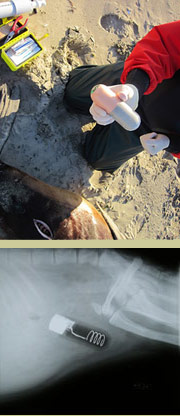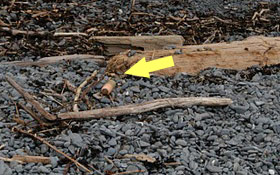Life History Transmitter (LHX) Tags
 Dr. Markus Horning (right) talks about his idea for the Life History Transmitter tags:
Dr. Markus Horning (right) talks about his idea for the Life History Transmitter tags:
“I specifically developed the concept of this highly specialized telemetry transmitter for the purpose of helping us address the many questions surrounding the past and present population trends in Steller sea lions. I wanted a telemetry device that could give us very specific information on individual Steller sea lions over the course of many years, and no matter where the animals might be and what might happen to them. I specifically wanted information on how long individual animals live, where they die, and how they die. Most of all, I was interested in finding out how many of them die from predation by sharks or killer whales.”
 When, Where, How
When, Where, How
LHX tags are designed to last for ten years or more and give valuable information about when, where and how an animal died. Researchers Dr. Horning and his Alaskan collaborator Dr. Jo-Ann Mellish implant two LHX tags each inside the body of young Steller sea lions. They use two tags to ensure that they will hear from at least one if not both tags. (See below: Why two tags? )
The LHX tags immediately begin monitoring the sea lion’s body temperature, immersion in water or air, and other sensors. However, they do not transmit until after the animal has died. LHX tags regularly check the state of their animal: is it alive or is it dead? Tags know an animal has died from temperature changes. Once an animal has died, it naturally cools to the surrounding temperature. Then the tag must find out whether it is still inside of the dead body or has come out of the body. The tags know they can transmit primarily when seeing daylight or sensing surrounding air. Outside of the body the transmitter signal is strong enough to reach an orbiting satellite. Tags cannot reach a satellite when transmitting inside the animal’s body. Then they can begin to transmit all the data they have previously stored throughout animal’s life.
Temperature changes do tell more of a story than just when a sea lion died. They give clues to why an animal died. Just how quickly the dead body cools to match the surrounding temperature also tells scientists how large the animal was at time of death. Visit the Animal Crime Scene Investigations page for more information>>
Why Two Tags?
 Sea lions lose all of their hair once a year in a process called molting, usually during the summer months. For this reason externally attached electronic tags fall off when the animals molt. The only option for tagging them for more than 12 months is to use an implanted tag. However, even the most robust electronics sometimes fail. The battery can go dead or the tag can work but be stuck under a rock where it cannot transmit. Normally, if researchers do not hear from an LHX tag, the animal is probably still alive. However, it is also possible that the animal has died and the tag has failed. To increase the likelihood that researchers will hear from a tag once the animal dies, they use two LHX tags in each sea lion. This makes it twice as likely that they will find out when an animal dies.
Sea lions lose all of their hair once a year in a process called molting, usually during the summer months. For this reason externally attached electronic tags fall off when the animals molt. The only option for tagging them for more than 12 months is to use an implanted tag. However, even the most robust electronics sometimes fail. The battery can go dead or the tag can work but be stuck under a rock where it cannot transmit. Normally, if researchers do not hear from an LHX tag, the animal is probably still alive. However, it is also possible that the animal has died and the tag has failed. To increase the likelihood that researchers will hear from a tag once the animal dies, they use two LHX tags in each sea lion. This makes it twice as likely that they will find out when an animal dies.
Researchers can actually calculate just how likely it will be that a tag cannot talk to a satellite. They do this by comparing the number of times they hear from both tags to the number of times they hear from only one of the two tags inside of an animal. Scientists have an interesting way of testing how well this idea works. They place two LHX tags into the bodies of dead sea lions (carcasses) that are sometimes found on beaches. Then, researchers return the dead bodies with the tags inside to deserted beaches or tow them out to sea. They wait to see if they hear from one or both tags and how long that will take. Check under What Are We Learning to find out how well the LHX tag idea works.
Researchers may not hear from a tag for many years. But says Dr. Horning, “Once an animal dies, we get some amazing data we could not get by any other means, no matter where the animal may have moved and where or when it might have died. In other words, we will eventually get data no matter what might have happened to the body.”
How does the tag get out of the animal’s body once it dies?
 This happens by a number of natural processes. Most likely, the body of a dead animal will decompose and break apart. In this process the organic material that makes up bodies is gradually broken down physically and chemically into smaller pieces and simpler forms of matter. The process is initiated almost immediately after death by the body’s very own enzymes and chemicals, in a process called ‘autolysis’ (self-digestion). Internal bacteria present in all living vertebrates, and external bacteria that occur in the environment soon contribute to the decomposition through a process called ‘putrefaction’. Often putrefaction produces gas, which may cause dead bodies to float at sea and be washed ashore. Nature further helps this process along through scavengers that consume portions of the carcass. For example, in the oceans there are many scavenging organisms, such as worms, crustaceans, but also some fish. Along the shore, other scavengers may contribute to the process, such as vultures, eagles, foxes, rodents, crabs, insects and others. Once the decomposition process is sufficiently advanced, the remains of the body simply fall apart and the LHX tag comes out.
This happens by a number of natural processes. Most likely, the body of a dead animal will decompose and break apart. In this process the organic material that makes up bodies is gradually broken down physically and chemically into smaller pieces and simpler forms of matter. The process is initiated almost immediately after death by the body’s very own enzymes and chemicals, in a process called ‘autolysis’ (self-digestion). Internal bacteria present in all living vertebrates, and external bacteria that occur in the environment soon contribute to the decomposition through a process called ‘putrefaction’. Often putrefaction produces gas, which may cause dead bodies to float at sea and be washed ashore. Nature further helps this process along through scavengers that consume portions of the carcass. For example, in the oceans there are many scavenging organisms, such as worms, crustaceans, but also some fish. Along the shore, other scavengers may contribute to the process, such as vultures, eagles, foxes, rodents, crabs, insects and others. Once the decomposition process is sufficiently advanced, the remains of the body simply fall apart and the LHX tag comes out.